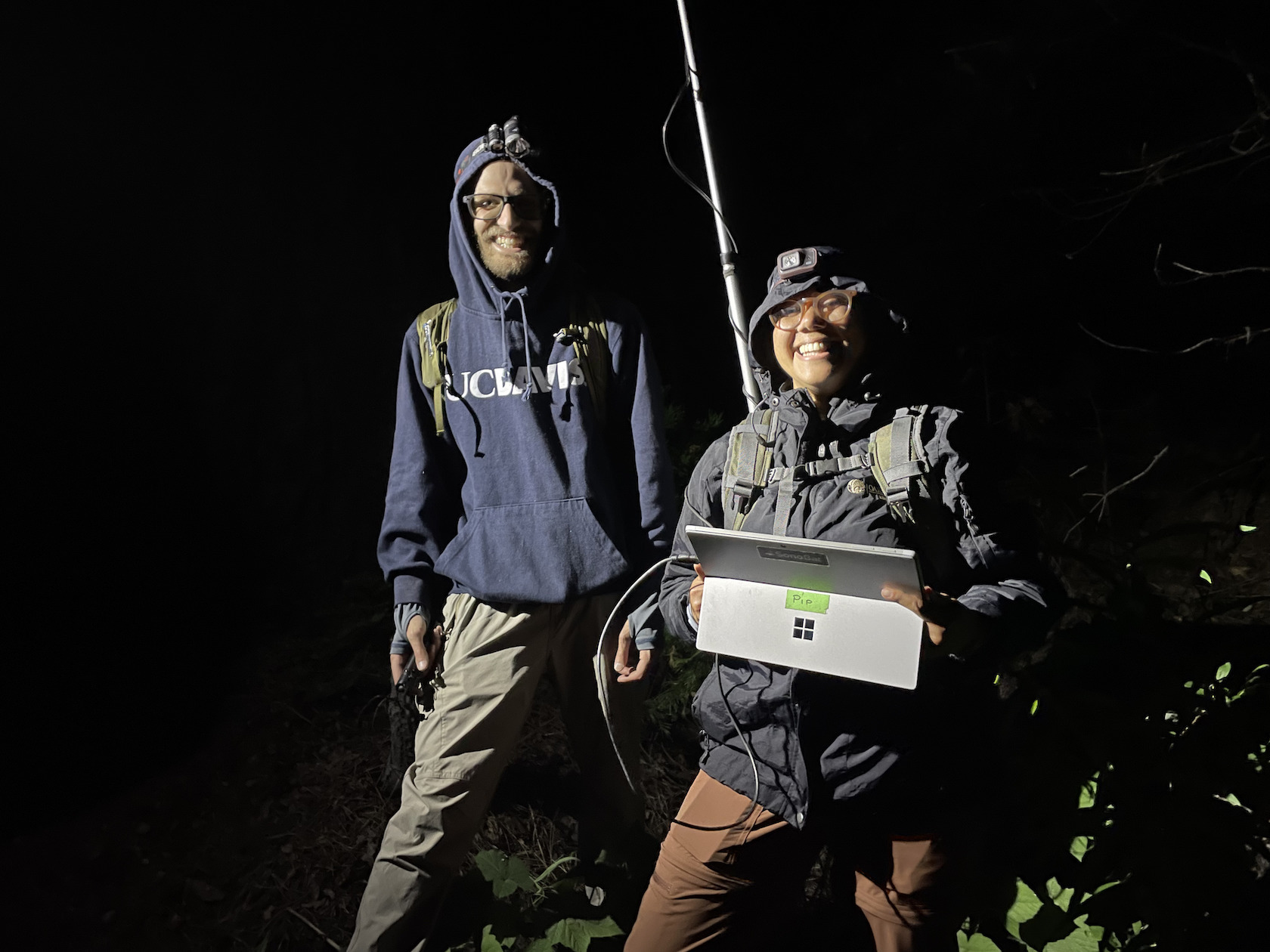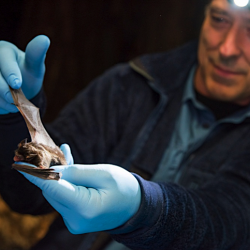BIO 315 Ecology and Conservation of California Bats
Dates: July 20-25, 2025
Instructor: Joe Szewczak
Fee: $395.00 + meals and accommodations fees
Units: 1
Term: Summer 2025
Course Description
This course will train participants in techniques for assessing bats in their natural habitat. In the local area surrounding the Sierra Nevada Field Campus we can expect to encounter as many as 17 of California's 23 bat species. Participants are introduced to various contact and non-contact survey methods including mistnetting, acoustic surveys, and roost recognition and evaluation. We will develop and discuss the habitat requirements and special considerations for individual species with an emphasis on conservation, management, and mitigation strategies. The course will develop an understanding of bat biology as a foundation for understanding the special environmental needs of bats. The class will meet in a seminar format to involve all students in developing principal concepts from readings and discussions. However, much of the learning will be in the field to provide a hands-on learning experience with the goal of developing discriminating techniques of data collection and analysis. The course will focus on preparing personnel engaged in wildlife management roles, but remains open to anyone with an interest in bat natural history and wildlife biology.
Rabies vaccination is not a requirement for taking this course, but it is a requirement if you wish to participate in handling live bats. If you think you might ever handle live bats, or any other wild mammal, we encourage you to go ahead and get vaccinated. When properly administered it provides an essentially lifetime immunization (authorities recommend a regular titer checks). The procedure involves a series of three injections over a period of weeks, and best to allow a month post injection for seroconversion (plan ahead). The injections are similar to a tetanus shot. To handle bats, proof of vaccination (or titer, see below) is required by the time the course convenes.
If you were previously vaccinated for rabies, unless you have already done so within the past year, we recommend that you get your rabies titer checked to confirm your protection. This link provides resources that you can give to your health care provider if they do not already know how to check your rabies titer. Request RFFIT endpoint for the most informative result.
CDC Guidance on Rabies Vaccinations and Titer Checks
1. Recommendations for rabies pre-exposure vaccines and timing of titer checks for bat handlers and other risk groups: https://www.cdc.gov/rabies/prevention/pre-exposure_vaccinations.html
2. Technical explanation of rabies titer checks: https://www.cdc.gov/rabies/specific_groups/hcp/serology.html


Instructor Bio
Joe Szewczak, B.S.E. (1980) Duke University, Ph.D. (1991) Brown University, is a Professor at Cal Poly Humboldt. His prior research investigated the extraordinary physiological capabilities of bats and other small mammals, from cold torpor to the intense demands of flight and high altitude, and the physiological ecology of bats, the integrated effects of the environment upon the organism. He documented that hibernating bats can go without breathing for two and a half hours, and determined the mechanism by which they accomplish such a feat. Much of his current focus has sought to improve non-invasive recognition of bats and birds and this lead him to develop SonoBat and SonoBird software to analyze and interpret bat and bird vocalization. Dr. Szewczak has taught bat field courses and workshops for more than two decades throughout the country and abroad. Learn more about Joe here or contact him: joe@humboldt.edu
Course Details
Course Schedule
Plan to arrive at the Sierra Nevada Field Campus on Sunday evening. If you arrive by 6 p.m. you can join the dinner. We will begin the class Monday morning, but thereafter we will meet mid-morning and the afternoons for class work, then spend our evenings in the field, typically past midnight. Class will conclude by Friday noonish.
Access to our survey sites will entail short hikes of a mile or less, sometimes over irregular terrain.
Grading: Students desiring a grade may take a written exam in the final class meeting.
Supplies List
- Headlamp.* As much of our experience together will be nocturnal, dependable sources of light will be essential. To keep your hands free, we recommend a good head lamp with one or more back-up lights, such as a mini headlamp, should your primary light fail. The rechargeable Black Diamond Icon and Petzl Duo are good choices because they have both a low beam for close work and high beam for checking the nets at a distance.
- Batteries. Rechargeable Li-ion batteries work wonders and reduce waste. Many current headlamps come supplied with rechargeable Li-ion batteries.
- Optional: A bright spot light for checking nets and foraging bats will augment your head lamp, but is not essential.
- Handling Gloves. A bright spot light for checking nets and foraging bats will augment your head lamp, but is not essential.
- Handling Gloves. For handling bats, we will use nitrile gloves as per White Nose Syndrome protocol. We also recommend more protection particularly until they gain more skill handling bats. For this purpose, select thin, supple leather gloves - find a pair that fits your hand well and lets you retain your dexterity; the thinner the leather the better to afford dexterity. Some driving gloves work nicely. Note: please do NOT bring handling gloves that have been used in any Pd/WNS-positive site or state. In that case, please purchase new gloves. (The same applies for all bat handling gear.)
- Waders/Boots. As many of our netting sites span water, if you plan to help set and check nets, hip waders make trips into the stream more pleasant on cool nights, in a pinch any other foot gear (and pants) that you don't mind getting wet will work (if you don't mind getting cold!); but we don't recommend this approach.
- As water levels vary each year, often knee-high rubber boots may be sufficient; however, we won't know until we get to our sites. Note: During the course, we will use bleach solution to disinfect boots between field sites in different watersheds.
- N95/KN95 masks for field work to prevent transmission of Covid-19 from humans to bats. This is a requirement of California permits and is in accordance with IUCN recommendations and CDFW permit protocols to protect the bats from transmission of Covid-19 from humans to bats).
- Discretionary Gear. Bring binoculars, a notebook, day pack, water bottle, and any other gear you typically carry with you in the field.
* Disinfect your gear: To minimize potential transport of invasive species and pathogens into our field sites, please bring only clean and disinfected gear. Particularly, please ensure that 1) you DO NOT BRING ANY GEAR that has been used at Pd/White-nose-syndrome-positive sites, or that has been used caving or exploring other underground habitats in WNS-positive states, 2) your boots and waders have been cleaned and disinfected before arrival per protocols for aquatic invasives and pathogens, 3) your hiking boots are not likely to spread seeds or sudden oak death. You can find specific protocols and read more about these issues in the links in the Reading section.
Clothing:
Nights near the Field Campus can often approach freezing, and even relatively mild nights seem cold when sitting in wait for bats. So bring plenty of warm gear, sweaters, gloves, hats, rain gear, and long underwear to provide a variety of layering options to "suit" the conditions.
Miscellaneous:
- day pack
- sunscreen
- insect repellant
- alarm clock
- water bottles
- plastic containers for packed lunches
Reading:
A compilation of readings and handouts will be prepared for each student. Please expect to help support the costs of this content, which should come to about $35.
A good read for a general overview of bats and their behavior:
- Altringham, John D. 1996. Bats: Biology and Behavior. Oxford University Press.
For the serious-minded, a book with something about everything to do with bats:
- Kunz, T.H., and S. Parsons 2009. Ecological and Behavioral Methods for the Study of Bats, 2nd edition. Smithsonian Press, Washington, D. C. 901 pp.
We will have most of these books (and other materials) available during the class.
- Kunz, T.H. 2006. Bat Ecology
- Altenbach, J. S. and E. D. Pierson. 1994. The importance of mines to bats: an overview.
- Barbour, R. W. and W. H. Davis. 1979. Bats of America.
- Barclay, R.M.R and R.M. Brigham (ed.). 1996. Bats and Forests Symposium, October 19-21, 1995, Victoria, British Columbia, Canada.
Bats and Forests Symposium (PDF) - Fenton, M. B. 1983. Just Bats.
- Fenton, M. B. 1992. Bats. Facts on File, New York. 207 pp.
- Findley, J. S. 1993. Bats, a Community Perspective.
- Ingles, L.G. Mammals of the Pacific States.
- Kunz, T.H. and P.A. Racey 1998. Bat Biology and Conservation. Smithsonian Institution Press, Washington, D.C. 365 pp.
- Tuttle, M. D. 1988. America's Neighborhood Bats. Univ. of Texas Press.
- Tuttle, M. D. and A. R. Taylor. 1994. Bats and Mines. Bat Conservation International, Austin, TX. 42 pp.
* Gear decontamination protocols and information links:
1. White-nose Syndrome Decontamination
https://www.whitenosesyndrome.org/static-page/decontamination-information
2. Wetland invasives, pathogens. Simple approach:
http://www.mndragonfly.org/pdf/Protocol%20for%20Wetland%20Decontamination.pdf
More resources:
https://www.youtube.com/watch?v=YMI4hgeMMAw&list=UUlrumrB_lrzOL8S-xv9FaPQ&index=1
California Department of Fish & Wildlife, Aquatic Invasive Species Decontamination Protocol 2022
https://nrm.dfg.ca.gov/FileHandler.ashx?DocumentID=92821
3. Sudden Oak Death (see section, "Sanitation Measures to Minimize Pathogen Spread")
https://www.suddenoakdeath.org/wp-content/uploads/2014/12/landscaper-1-08-with-new-2014-map.pdf
4. Human transmission of Covid-19 to wildlife. IUCN guidance for bat research:
https://www.iucnbsg.org/uploads/6/5/0/9/6509077/amp_recommendations_for_researchers_final.pdf
Lodging and Camping Supplies
Camping gear if you are staying on campus:
- tent and sleeping pad (unless you are staying in our tent with a cot provided)
- warm sleeping bag
- pillow, toiletries, and towel
- flashlight and lantern
- alarm clock
Field gear for everyone:
- day pack
- sunscreen
- insect repellant
- water bottles
- plastic containers for packed lunches
- sense of humor
You might also want to bring:
- camera
- binoculars
- hand lens
- camp chair
Clothing:
The weather in the Sierra Nevada can vary greatly, even in a single day. Be prepared for chilly temperatures at night, even below freezing early in the summer. Rain is a possibility any time, whether forecast or not. Variable weather clothing that can be layered is best: long pants and a long-sleeved shirt, warm sweater and jacket, t-shirt and shorts or skirt, sturdy shoes or hiking boots, sun hat, rain gear, and a warm hat or gloves for cold weather and/or night activities. And, if you come later in the season, bring your swimsuit for afternoon dips in the lakes!
Adobe Acrobat Reader is required to view PDF files. This is a free program available from the Adobe web
site. Follow the download directions on the Adobe web site to get your copy of Adobe Acrobat Reader.
The documents on this website/webpage might not be fully accessible to persons with disabilities. We are working to
fix these accessibility barriers by the end of the year. If you have trouble in accessing this content, please contact (415) 338-1111 and we will provide you with accessible alternatives.